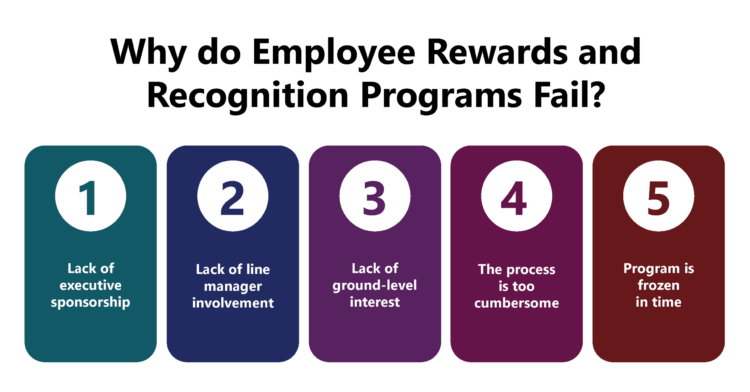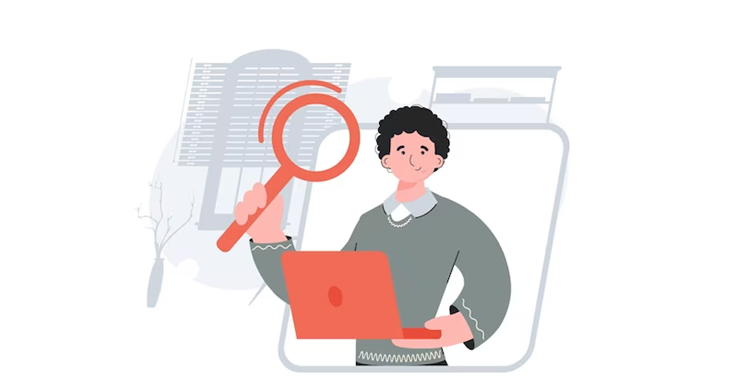1. Employee rewards and recognition programs often fail due to a lack of sustained executive sponsorship, insufficient involvement from line managers, diminishing ground-level interest, overly complex processes, and outdated program structures.
2. To succeed, these programs need continuous support, simplicity, regular updates, and alignment with evolving organizational goals and employee expectations.
Generally, organizations launch employee rewards and recognition programs with great fanfare and top-level executive involvement. However, there are many reasons why employee rewards and recognition programs fail. In this article, we take a look at a few possible reasons:
1. Lack of executive sponsorship
2. Lack of line manager involvement
3. Lack of ground-level interest
4. The process is too cumbersome
5. The program is frozen in time


Leadership involvement tends to decrease over time, and employee rewards and recognition are among the various HR initiatives.
Leaders tend to shift focus to other initiatives and lose interest in the program as it becomes largely operational.
Organizations with solid operations and a strong focus on people tend to fare better than others.
It is because crucial employee rewards and recognition-related metrics become integral to their internal operational reviews.

Line managers hold the key to successfully implementing employee rewards and recognition programs.
However, if organizations do not involve them during the design and planning, they will perceive it as another management initiative.
This cynicism percolates to their team members and eventually to the entire organization.
Employee rewards and recognition programs aim to create a culture of appreciation. Frontline managers and supervisors play a critical role in the program’s success.
Hence, managers should be involved in the program’s planning and rollout, and incorporate participation in the program into their Key Results Areas (KRAs).

Employees may lose interest in the program over time due to its diminishing importance or visibility.
It could also be due to a disconnect with the program objectives or a messed-up implementation from the very inception.
If the organization creates a program without proper input from employees or line managers, then it may fall flat.
It might meet the same fate as other initiatives once the initial enthusiasm disappears. Hence, organizations should plan employee rewards and recognition programs only after a dipstick with the employees.

Implementation challenges might also derail the success of employee rewards and recognition programs.
For example, a cumbersome process with too many criteria might make it difficult for managers to recognize employees.
An operations-heavy process will deter them from going ahead and participating in the program.
It applies to employees as well. If the reward process is too cumbersome, employees might not want to participate.
Hence, the process must be intuitive and straightforward. Digitizing and automating it might be the icing on the cake.

Employee rewards and recognition programs lose their relevance over time.
They need to be tweaked regularly to keep pace with the changing requirements of the organization and the workforce.
Organizational priorities may change over time as the organization grows and the business environment evolves.
For example, achievements related to revenue generation may be of the utmost importance when the organization is in its growth phase.
Over time, as the growth slows and the organization matures, there might be an increased focus on cost-saving initiatives.
Also, the changing workforce profile might impact employee rewards and recognition program expectations.

Younger and more tech-savvy millennials entering the workforce, as well as an increasing number of female employees, would create different expectations from the program.
Peer recognition and self-nomination are becoming mainstream in most employee rewards and recognition programs.
Recognition should not be exclusive to the management. The goal should be to create a culture of appreciation in the organization.
Management should act as catalysts for the program, giving it the required importance and visibility in all possible forums.
Hence, organizations should invest in tools that digitize, automate, and streamline employee rewards and recognition programs, minimizing operational issues.
Here are a few key reasons why employee rewards and recognition programs often fail.
Leaders and HR must avoid these pitfalls to maintain employee motivation and productivity. And honestly, this is hardly rocket science.
Employee rewards and recognition programs need continuous support from the management and regular efforts from HR to keep them in sync with changing needs.
“Change is the only constant” applies to employee rewards and recognition programs.
They must evolve and adapt to the changing organizational priorities, work practices, and employee preferences.

Lead author: Sagar Chaudhuri, the Co-Founder and CEO of HiFives. He is an HR Tech Evangelist with over 25 years of experience in both corporate and entrepreneurial settings. Previously, Sagar has held leadership roles with companies such as Genpact, Infosys, and ICICI Bank. He has an engineering degree from IIT Kharagpur and an MBA from IIM Lucknow. Connect on LinkedIn
To stay updated on the latest HiFives blogs, follow us on Twitter (@MyHiFives)